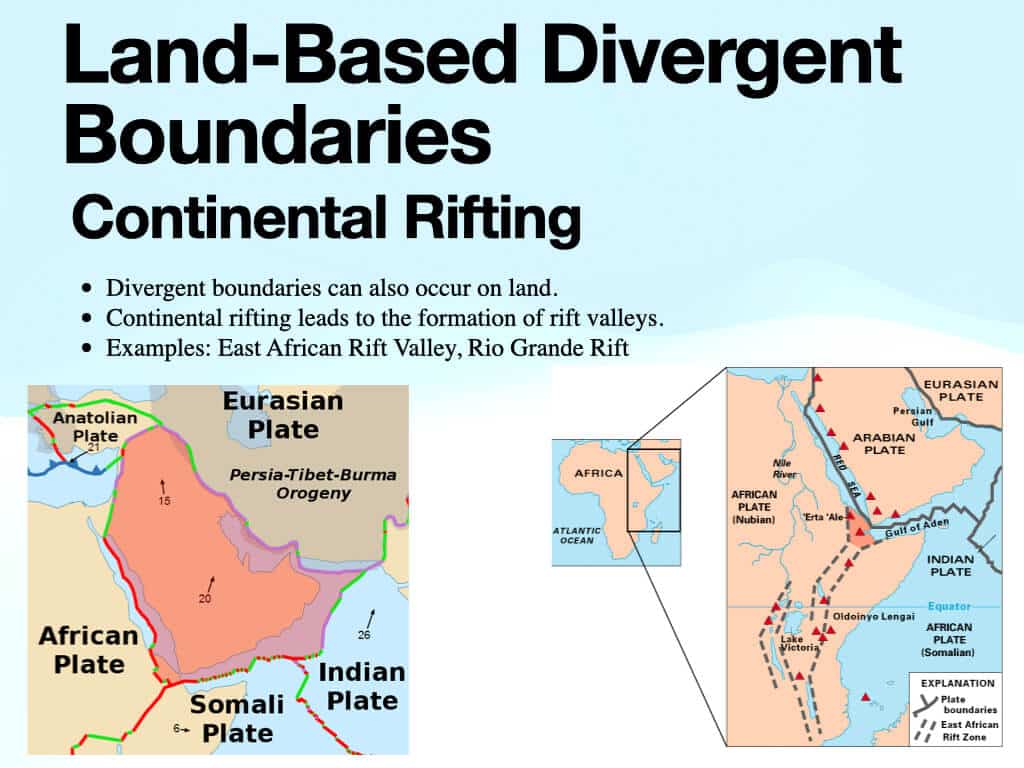What Happens at a Divergent Plate Boundary
Divergent, convergent, and transform Plate Boundary
Divergent Plate Boundaries: Where Continents Tear Apart
Divergent plate boundary is the main cause of the continent to tear apart and started to form a mountain. The driving force is the convection current from the mantle.
The Birth of New Crust and Oceans
The divergent boundary start to form a oceanic crust and ultimately a oceans because ocean water is on the oceanic crust.
At divergent boundaries, tectonic plates move away from each other
The divergent boundary occur when the two plates move away from each other.
Most divergent boundaries occur along mid-ocean ridges.
New oceanic crust is created at these boundaries.
Seafloor Spreading
-
- The process of seafloor spreading.
- Upwelling of magma from the mantle.
- Formation of new oceanic crust.
- Magnetic anomalies as evidence of seafloor spreading.
Land-Based Divergent Boundaries
Continental Rifting
- Divergent boundaries can also occur on land.
- Continental rifting leads to the formation of rift valleys.
- Examples: East African Rift Valley, Rio Grande Rift
Geological Features of Divergent Boundaries
Mid-ocean ridges: underwater mountain ranges.
Rift valleys: deep, elongated valleys.
Volcanic activity: due to the upwelling of magma.
Earthquakes: frequent and often shallow.
Convergent Plate Boundaries: Where Worlds Collide
The Forces Shaping Mountains, Volcanoes, and Trenches
Types of Convergent Boundaries
Oceanic-Continental Convergence:
Subduction of oceanic plate beneath continental plate.
Oceanic-Oceanic Convergence:
Subduction of one oceanic plate beneath another.
Continental-Continental Convergence:
Collision of two continental plates.
Oceanic-Continental Convergence
Denser oceanic plate subducts beneath less dense continental plate.
Formation of deep-sea trenches.
Melting of subducting plate leads to volcanic activity.
Formation of continental volcanic arcs (e.g., Andes Mountains).
Earthquake generation.
Oceanic-Oceanic Convergence
Island Arcs and Deep Trenches
Older, denser oceanic plate subducts beneath younger, less dense oceanic plate.
Formation of deep-sea trenches.
Volcanic activity leads to the formation of island arcs (e.g., Japan, Philippines).
Earthquake generation.
Continental-Continental Convergence
Mountain Building and Crustal Thickening
Collision of two continental plates.
No subduction due to similar densities.
Crustal thickening and folding lead to the formation of mountain ranges (e.g., Himalayas).
Large scale faulting.
Earthquake Generation.
Geological Features and Hazards
- Deep-sea trenches.
- Volcanic arcs and island arcs.
- Folded mountain ranges.
- Earthquakes (including megathrust earthquakes).
- Tsunamis.
Transform Fault Boundaries: Where Plates Slide Past Each Other
Where Plates Slide Horizontally
At transform fault boundaries, tectonic plates slide past each other horizontally.
These boundaries are also known as conservative plate margins because they neither create nor destroy lithosphere.
The San Andreas Fault
The San Andreas Fault is a well-known example of a transform fault boundary.
It separates the Pacific Plate and the North American Plate.
The relative motion between the two plates is approximately 5-6 centimeters per year.
Geological Features of Transform Boundaries
Earthquakes: Frequent and often shallow earthquakes are characteristic of transform boundaries.
Fault scarps: Vertical displacements along the fault can create steep cliffs.
Offset features: Rivers, roads, and other features can be offset by the movement of the fault.
What Happens at a Divergent Plate Boundary Images
Download From Google Drive (For Mac Keynote) Divergent
